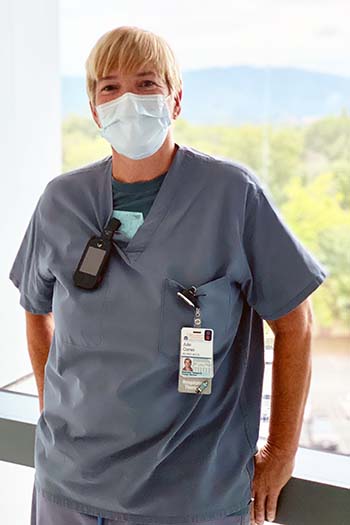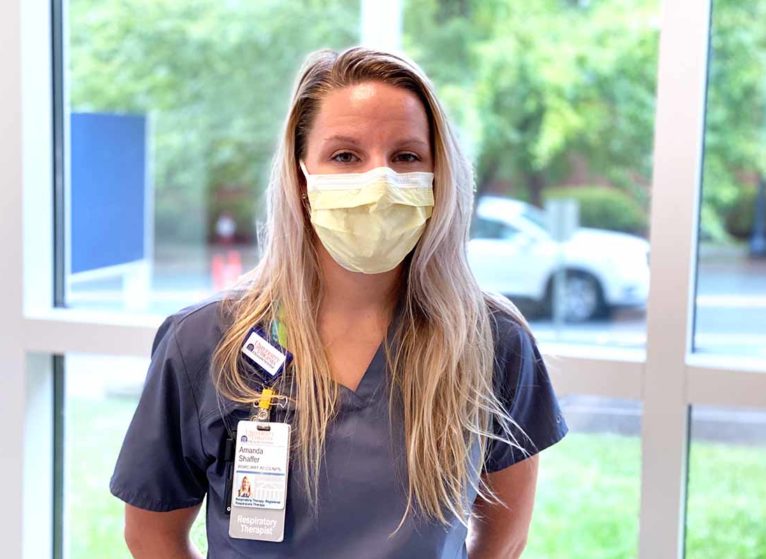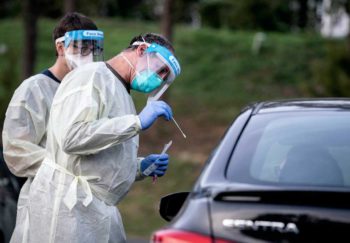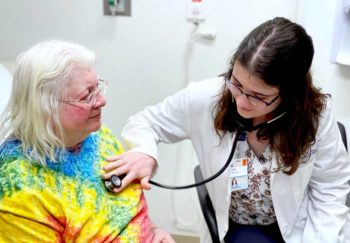2021 was another hard year. But our team of employees, students, and volunteers rose to the occasion, doing whatever it took to help our patients and our community. Here’s one of our favorite stories that helped us make it through 2021.
Respiratory therapist (RT) Julie Comer says one of the best parts of her job is when COVID-19 patients finally start to get better. Someone who’s been in the ICU for weeks or months eats, walks, speaks, and ultimately goes home.

These are the bright spots of a job that’s tough in “normal” times and, since March 2020, has been absolutely exhausting.
What Does a Respiratory Therapist Do?
The average person doesn’t necessarily think of respiratory therapists when they hear about the healthcare providers at the frontlines of COVID. But these breathing experts are a critical part of the care team for many patients. They:
- Manage ventilators and other equipment that helps patients breathe
- Perform lung function tests
- Keep the patient’s airways clear
- Teach patients and families how to manage equipment at home
- Help diagnose sleep disorders like sleep apnea
“RTs choose this profession because they feel joy out of making a difference in the lives of people who are in distress and almost, or are, at the brink of death,” says respiratory therapist Bessie Brooks. “Even though we support our patients with their breathing issues, we also develop a relationship, bond, and trust with them that they will never forget.”
Beyond COVID, their patients have pneumonia, asthma, cystic fibrosis, severe flu, and other conditions that impact their ability to breathe. Respiratory therapists also work with pediatric patients.
Meet Some UVA Respiratory Therapists
Michael O’Brien, Pediatric Clinic & Pediatric Home Ventilator Program Specialist
O’Brien says: “I advise physicians in the care of children with complex medical needs and manage children with tracheostomy tubes and ventilators.
One project I'm proud of is UVA's Pediatric Home Ventilator Program, which I helped create and shape. It was born from the twin needs for an interdisciplinary team to follow complex children after discharge and the need to systematically and effectively train caregivers to care for these children.”
Bessie Brooks, Respiratory Therapy Shift Lead
Brooks says: “I ensure we have enough staff, equipment, and supplies for our RT team to do its job.
I also troubleshoot difficult RT patients. I develop treatment plans for patients in the Emergency Department who come in with breathing problems such as asthma, chronic obstructive pulmonary disease (COPD) exacerbation, drug overdose or traumas. I make sure that the managers and directors are aware of what is going on clinically at the bedside.”
Amanda Shaffer, UVA Children’s
Shaffer says: “I am currently based in the children’s hospital so I move around between the pediatric and newborn intensive care units and pediatric acute care. I also have about 5 years of experience as an adult respiratory therapist. So I float around to all areas of the hospital depending on the type of help that is needed.
Most of my patients are in respiratory failure or recovering from respiratory failure and require mechanical ventilation and/or breathing therapies and medication. My patients range from premature infants whose lungs have not developed yet to pediatric patients who have just returned from surgery for their congenital heart defect.
I take care of patients on and off mechanical ventilation (breathing machines). I also see patients with asthma, cystic fibrosis, genetic disorders, RSV, and after a traumatic accident, to name a few.”
How COVID Changed Their Worlds
Since COVID can cause severe respiratory issues, there’s more demand for respiratory therapists. This means they have to see more patients every day than they used to. They often take on longer days and extra shifts to help out.
That alone could lead to burnout and exhaustion. But caring for COVID patients can also be emotionally draining. They take much longer to improve than, for example, someone with a bad case of pneumonia, Comer explains. There’s not much she can do beyond managing the patient’s ventilator and waiting. It’s “mentally exhausting,” she says.
And respiratory therapists are often present when a patient dies. But they keep going — there are others who need their help.
It takes a special person to provide this kind of care. It takes someone who truly cares about the patients and makes every attempt to save them.
“This pandemic has really put a burden on respiratory therapists, sometimes making them feel that what they are doing isn’t making a difference,” Brooks says. “I want my colleagues to know that we make a difference every day in our patients and their family lives, even when the outcome isn’t great. You do everything in your power to provide the best patient care to your patients.”



Thank you UVA respiratory therapists for all you do. You are so appreciated.